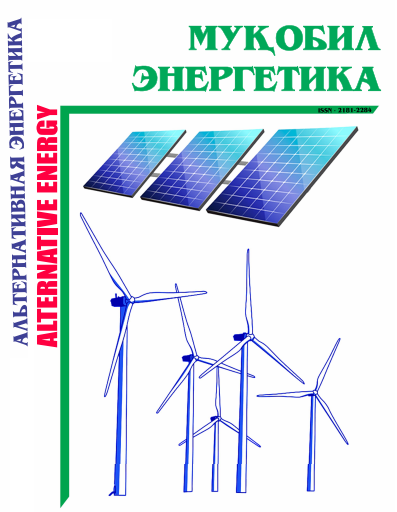STUDYING THE THERMAL-TECHNICAL REGIME OF THE OBTAINED ALTERNATIVE FUELS IN THE HELIOPYROLYSIS DEVICE
Keywords:
solar energy, parabolic concentrator, biomass pyrolysis, alternative fuel, solar heliopyrolysis device, biomass energy, pyrolysis reactor, thermal energyAbstract
Annotation. Introduction. The article presents the results of a thermal-technological regime study of the pyrolysis process of sunflower plant waste in a parabolic solar concentrator heliopyrolysis device. An experimental parabolic solar concentrator heliopyrolysis device was created to investigate the heliopyrolysis process. In the process of thermally processing sunflower plant waste, the dependency of the resulting products on temperature and the material balance were studied in experiments. In experiments conducted with the device, the pyrolysis of 1 kg of sunflower plant waste loaded into the heliopyrolysis reactor resulted in the production of 63% biochar, 10% liquid, and 27% gaseous fuels.
Methods and Materials. The material balance of biofuels separated from the biomass loaded into the parabolic solar concentrator heliopyrolysis reactor was carried out in laboratory conditions with an initial moisture content of 10% and a size of 6-8 mm. The studies were conducted on sunflower plant waste.
Results. According to the experiments conducted, it was found that the total yield of pyrolysis products varies little within the temperature range of 350-400°C. Thus, the pyrolysis of 1 kg of sunflower plant waste loaded into the experiment resulted in the production of 63% biochar, 10% liquid, and 27% gaseous fuels.
Conclusion. The developed parabolic solar concentrator heliopyrolysis device allows the use of solar heat to cover the energy needed for conducting cycles during daylight hours. Experimental studies carried out with the parabolic solar concentrator heliopyrolysis device revealed that it is possible to obtain solid, liquid, and gaseous fuel samples from the pyrolysis of sunflower plant waste.
Downloads
References
[1] Avezov, R.R., Vokhidov, A.U., Kuralov, M.A. Principles of development of solar energy in the Republic of Uzbekistan, Modern problems of renewable energy, A collection of materials of the respublican scientific-practical conference, Karshi, March, 18, 11-13 (2018)
[2] Abdurakhmanov, A., Kuchkarov, A.A., Holov, Sh.R., Abdumuminov, A. “Calculation of optical-geometrical characteristics of parabolic-cylindrical mirror concentrating systems”, European science review. 2017. Vol. 2. P. 201-204.
[3] Klychev, Sh.I., Zakhidov, R.A., Bakhramov, S.A., Dudko, Yu.A., Khudoikulov, A.Ya., Klychev, Z.Sh., Khudoiberdiev, I.A. “Parameter optimization for paraboloid-cylinder-receiver system of thermal power plants”, Applied Solar Energy. Applied Solar Energy. 2009. Vol. 45. No. 4. pp. 281–284.
[4] Avezov, R.R., Avezova, N.R., Matchanov, N.A., Suleimanov, Sh.I., Abdukadirova, R.D. “History and State of Solar Engineering in Uzbekistan”, Applied Solar Energy, 2012, Vol. 48, No. 1, pp. 14–19.
[5] Amal, E.K., Oumaima, E.A., Elhassan, A. CFD Simulation of Temperature Distribution in a Parabolic Trough Collector. Appl. Sol. Energy 59, 311–323 (2023).
[6] Koishiyev, T.K., Bekzhan, Z.B., Saribayev, A.S. Optimization Issues, Computer Modeling, and Visualization of the Efficiency Coefficient of Optical Systems of Solar Furnaces and Solar Power Plants. Appl. Sol. Energy 59, 324–328 (2023).
[7] Abdurakhmanov, A.A. Akhadov, Zh.Z. Concentrating systems and determination of optimal parameters of the light-receiving surface, Appl. Sol. Energy, 2004, vol. 40, no. 3, p 39
[8] Akhadov, J.Z. Study of the Performance Characteristics of a Solar Concentrator for Production of Thermal Energy. Appl. Sol. Energy 59, 169–175 (2023).
[9] Li, R., Zeng, K., Soria, J.E., Mazza, G.A., Gauthier, Rodriguez, D.R., Flamant, G. Product distribution from solar pyrolysis of agricultural and forestry biomass residues. Renew. Energy 89, 27–35.
[10] Luzzi, A., Lovegrove. K. Solar Thermal Power Generation, Australian National University, Camberra, 2004, pp. 669–683.
[11] Nzihou, A., Flamant, G., Stanmore, B. Synthetic fuels from biomass using concentrated solar energy - a review. Energy 2012 (42), 121–131.
[12] Uzoqov G‘.N., Almardanov H.A. Biomassa geliopirolizi jarayonida suyuq mahsulotlarni chiqish miqdoriga ta’sir etuvchi parametrlarni baholash. // Fan va texnologiyalar. – 2023. – №6(58). – 45–53 b.
[13] Uzakov, G.N., Almardanov, X.A. Study of the Material Balance of a Heliopyrolysis Device with a Parabolic Solar Concentrator. Appl. Sol. Energy 59, 739–746 (2023).
[14] Uzakov G.N., Novik A.V., Davlonov X.A., Almardanov X.A., Chuliev S.E. Heat and Material Balance of Heliopyrolysis Device. Energetika. Proceedings of CIS higher education institutions and power engineering associations. 2023; 66(1):57-65.
[15] Uzakov, G.N., Almardanov, X.A., Kodirov, I.N., Aliyarova, L.A. Studying the temperature regime of the heliopyrolysis device reactor. E3S Web of Conferences, 2023, 411, 01040.
[16] Davlonov X., Study on heat and material balance of heliopyrolysis device, AIP Conference Proceedings, 2686, 020023 (2022)
[17] Almardanov, H. and Chuliyev, S. 2022. Biomassadan geliopiroliz usulida yoqilg‘i olish tajriba qurilmasining parametrlarini asoslash. Innovatsion texnologiyalar. 1, 4 (Nov. 2022), 92–96.
[18] G.N. Uzakov, X.A. Almardanov, I.N. Kodirov, L.A. Aliyarova. Modeling the heat balance of a solar concentrator heliopyrolysis device reactor. BIO Web Conf., 71 (2023) 01098.






